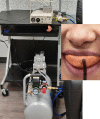Study protocol of an investigation of attention and prediction error as mechanisms of action for latent inhibition of dental fear in humans
- PMID: 36698206
- PMCID: PMC9875450
- DOI: 10.1186/s40359-023-01054-0
Study protocol of an investigation of attention and prediction error as mechanisms of action for latent inhibition of dental fear in humans
Abstract
Background: Evidence suggests that dental anxiety and phobia are frequently the result of direct associative fear conditioning but that pre-exposure to dental stimuli prior to conditioning results in latent inhibition of fear learning. The mechanisms underlying the pre-exposure effect in humans, however, are poorly understood. Moreover, pain sensitivity has been linked to dental fear conditioning in correlational investigations and theory suggests it may moderate the latent inhibition effect, but this hypothesis has not been directly tested. These gaps in our understanding are a barrier to the development of evidence-based dental phobia prevention efforts.
Methods: Healthy volunteers between the ages of 6 and 35 years will be enrolled across two sites. Participants will complete a conditioning task in a novel virtual reality environment, allowing for control over pre-exposure and the examination of behaviour. A dental startle (a brief, pressurized puff of air to a tooth) will serve as the unconditioned stimulus. Using a within-subjects experimental design, participants will experience a pre-exposed to-be conditioned stimulus, a non-pre-exposed to-be conditioned stimulus, and a neutral control stimulus. Two hypothesized mechanisms, changes in prediction errors and attention, are expected to mediate the association between stimulus condition and fear acquisition, recall, and retention. To ascertain the involvement of pain sensitivity, this construct will be measured through self-report and the cold pressor task.
Discussion: Dental phobia negatively affects the dental health and overall health of individuals. This study aims to determine the mechanisms through which pre-exposure retards conditioned dental fear acquisition, recall, and retention. A randomized control trial will be used to identify these mechanisms so that they can be precisely targeted and maximally engaged in preventative efforts.
Keywords: Dental phobia; Eye tracking; Fear learning; Latent inhibition; Pain sensitivity; Pre-exposure; Virtual reality.
© 2023. The Author(s).
Conflict of interest statement
The authors declare that they have no competing interests.
Figures
Similar articles
-
A test of pre-exposure spacing and multiple context pre-exposure on the mechanisms of latent inhibition of dental fear: A study protocol.BMC Psychol. 2024 Feb 21;12(1):85. doi: 10.1186/s40359-024-01580-5. BMC Psychol. 2024. PMID: 38383546 Free PMC article.
-
A study protocol testing pre-exposure dose and compound pre-exposure on the mechanisms of latent inhibition of dental fear.BMC Psychol. 2024 Jan 18;12(1):36. doi: 10.1186/s40359-024-01527-w. BMC Psychol. 2024. PMID: 38238866 Free PMC article.
-
Functional neuroimaging of associative learning and generalization in specific phobia.Prog Neuropsychopharmacol Biol Psychiatry. 2019 Mar 8;89:275-285. doi: 10.1016/j.pnpbp.2018.09.008. Epub 2018 Sep 25. Prog Neuropsychopharmacol Biol Psychiatry. 2019. PMID: 30266438 Clinical Trial.
-
The conditions that promote fear learning: prediction error and Pavlovian fear conditioning.Neurobiol Learn Mem. 2014 Feb;108:14-21. doi: 10.1016/j.nlm.2013.05.002. Epub 2013 May 16. Neurobiol Learn Mem. 2014. PMID: 23684989 Review.
-
Barriers and Drawbacks of the Assessment of Dental Fear, Dental Anxiety and Dental Phobia in Children: A Critical Literature Review.J Clin Pediatr Dent. 2017;41(6):399-423. doi: 10.17796/1053-4628-41.6.1. Epub 2017 Sep 22. J Clin Pediatr Dent. 2017. PMID: 28937891 Review.
Cited by
-
A test of pre-exposure spacing and multiple context pre-exposure on the mechanisms of latent inhibition of dental fear: A study protocol.BMC Psychol. 2024 Feb 21;12(1):85. doi: 10.1186/s40359-024-01580-5. BMC Psychol. 2024. PMID: 38383546 Free PMC article.
-
A study protocol testing pre-exposure dose and compound pre-exposure on the mechanisms of latent inhibition of dental fear.BMC Psychol. 2024 Jan 18;12(1):36. doi: 10.1186/s40359-024-01527-w. BMC Psychol. 2024. PMID: 38238866 Free PMC article.
References
-
- Siegel K, Schrimshaw EW, Kunzel C, Wolfson NH, Moon-Howard J, Moats HL, Mitchell DA. Types of dental fear as barriers to dental care among African American adults with oral health symptoms in Harlem. J Health Care Poor Underserved. 2012;23(3):1294–1309. doi: 10.1353/hpu.2012.0088. - DOI - PMC - PubMed
Publication types
MeSH terms
Grants and funding
LinkOut - more resources
Full Text Sources
Medical




